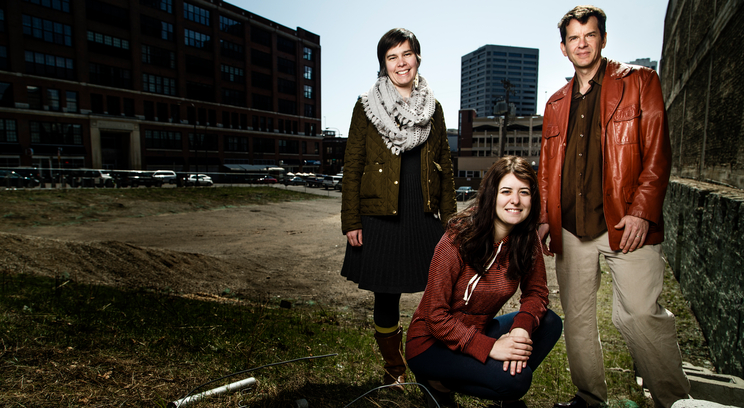A gravel pit on the corner of 10th and Robert in downtown St. Paul is about to get a "wild" makeover. This month, St. Thomas senior Elizabeth Chambers, junior Hunter Gaitan and sophomore Ryan Burke will help plant 96 plots of wildflowers – sunflowers, geraniums, black-eyed Susans, red phlox, lupine and blue indigo, and two varieties of legumes – to "the saddest urban lot you can imagine," according to their adviser, St. Thomas biology professor Adam Kay.
"We did a pilot project on campus last summer, but this summer we're going big," he noted of their plans for this year's garden, which will take up one-quarter of a city block.
"Last year we planted monocultures (one plant species per plot) and eight-species plots, then analyzed how they uptake nutrients. With this project, we're taking it a step further and focusing on heavy metal (lead, arsenic and cadmium, among others) uptake. So we're taking what we learned last year and applying it to a contaminated lot," Chambers elaborated.
The team named their endeavor The Helpful Flowers Project, and they hope it is helpful in more ways than one: to advance research in phytoremediation, the use of plants to remove pollutants from the environment or render them harmless; improve soil quality; promote biodiversity; build community; and contribute to city aesthetics. The group hand-picked certain species of flowers and legumes for their heightened abilities to extract heavy metals from soil.
The project is a collaboration with Amanda Lovelee, the City Artist in Residence of Public Art Saint Paul and St. Paul Parks and Recreation. Lovelee has created a design that will be visually stunning. Eight elongated plots will spiral out from a 25-foot-in-diameter cobblestone patio in a shape that mimics the Fibonacci sequence that Mother Nature embeds in the pinwheel-esque, mathematically precise pattern of nearly all sunflower heads. The site, known as the Urban Flower Field, recently was highlighted on Minnesota Public Radio. It is supported by the City of St. Paul and Public Art Saint Paul through an ArtPlace America grant.

The lot at the corner of 10th and Robert on April 22.
While the new garden will bump up the aesthetic beauty of the lot – which has remained vacant since the demolition of its former occupant, the Pedro Luggage building, in 2011 – Chambers, Gaitan and Burke will study native wildflowers and their ability, when combined, to extract heavy metals from the soil through phytoremediation. The team is particularly interested in whether biodiversity can boost the rate and benefits of the process.
"That's the novel idea behind this project," Kay said. "The idea that having mixtures of plant species can be more effective than monocultures for phytoremediation. Different plant species do different things for any number of reasons ... because their roots grow at different depths, and so on."
The group carefully hand-picked some plant species for their ability to capture nitrogen from the atmosphere and convert it into forms plants can use. (In a nutshell, the earth's atmosphere is 78 percent nitrogen, which is essential to plant growth; atmospheric nitrogen, however, is incompatible to plants' palates until it is fixed, or processed, into ammonium.)
They will use XRF (X-ray fluorescence), an instrument that resembles a price scanner, to measure soil and plant material for heavy metal content.
Gravel Pit ---> Urban Flower Field https://t.co/L5YJELRc8G #bioremediation #ecologicalgardens @UofStThomasMN @MCAD #MN pic.twitter.com/v74qxI30eW
— Lindsay Rebhan (@LSRebhan) May 14, 2014
The garden will serve as a transition space for a couple of years before the City of St. Paul turns the lot into a permanent park. Meanwhile, according to Kay and Chambers, St. Thomas biochemistry students will continue to analyze the flowers and legumes for phytoremediation for a few years. They project it will take around two years of research to determine if their project is successful in their intention to find the most effective way to use wildflowers. If it is successful, their method will prove to be a low-cost, environmentally friendly, community-energizing means to cleansing contaminated lots, which often remain vacant because they cannot be developed.
The Helpful Flowers Project is funded by a Young Scholars Grant through the Grants and Research Office.







